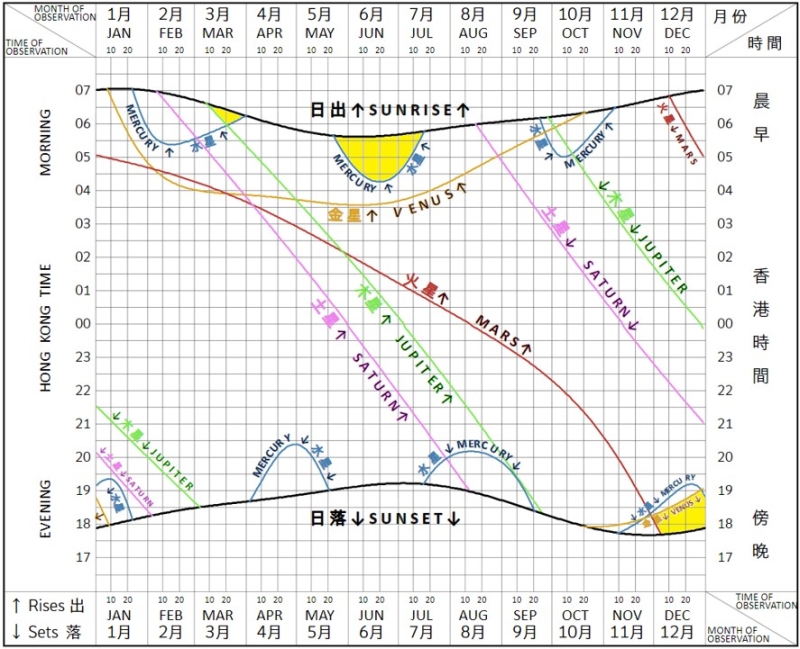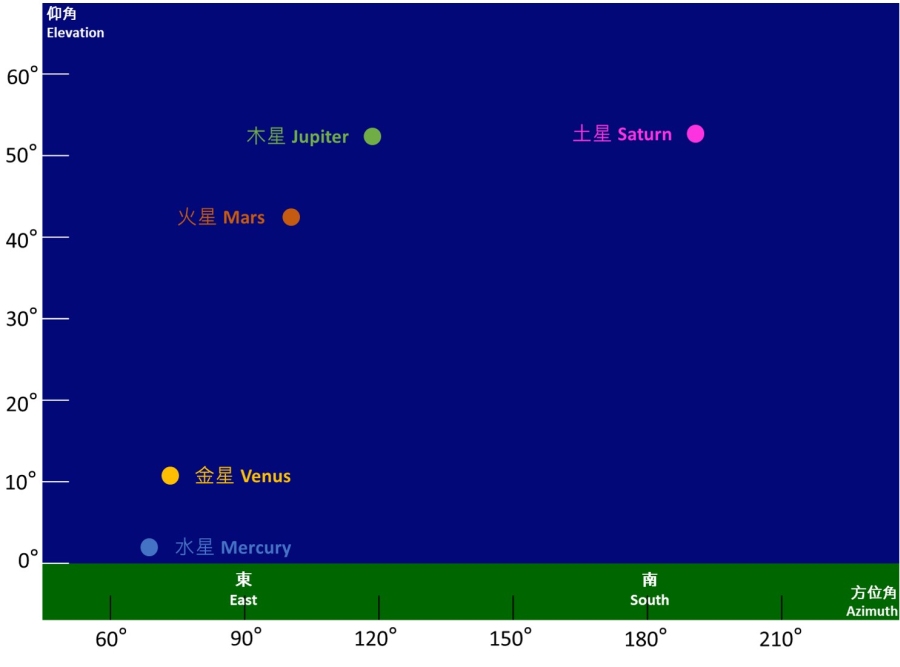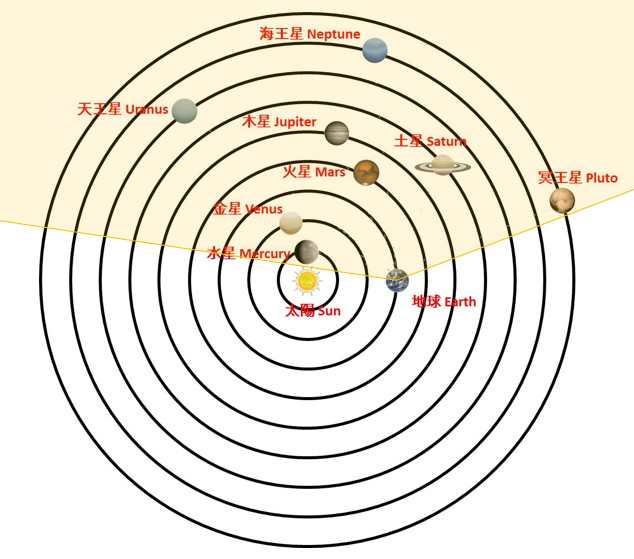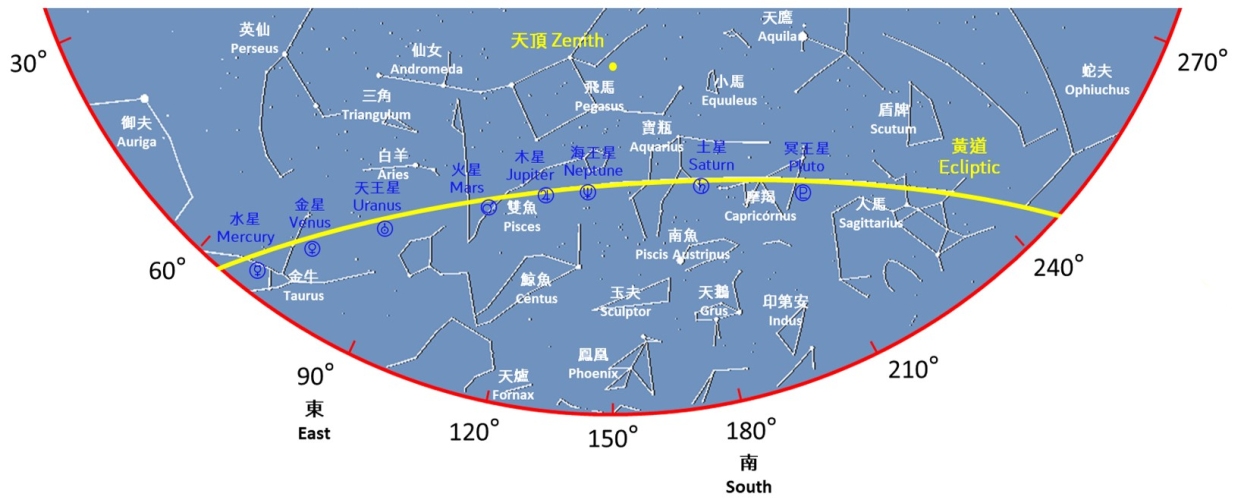Parade of the Planets
20 June 2022
David TW Hui and Shelby SY Chu"Parade of the Planets”, also commonly known as "Planetary Alignment”, will occur multiple times in the night sky of 2022. It means that the planets in the solar system will appear in a row when viewed from the Earth. Among the planets, five of them can be observed by the unaided eye. They include Mercury, Venus, Mars, Jupiter and Saturn. When these five planets appear in the sky simultaneously, the phenomenon is called a "Parade of the Five Planets". These planets, spanning across a large viewing angle, are best observed with naked eyes on clear nights.

Figure 1. Occurrence of "Parade of the Five Planets" marked in yellow on the chart of "Times of Rise and Set of the Sun and the Planets at Hong Kong". (Note 1)
The periods of the three episodes of "Parade of the Five Planets" in 2022 are indicated by yellow regions in Figure 1. Theoretically, the second round commenced on 22 May, but the best viewing period will be in mid to late June when the duration of the five planets simultaneously observable in the night sky is the longest. Take for example on 25 June 2022, among the five planets, Mercury will be the last one to rise from the East shortly before 4:30 am Saturn, Jupiter, Mars, Venus and Mercury will then appear at the same time in the night sky (Figure 2). The "Parade of the Five Planets" will last for more than an hour until the sky brightens up around dawn.

Figure 2. Schematic diagram showing the positions of Mercury, Venus, Mars, Jupiter, and Saturn at 4:30 am on 25 June 2022. (Note 1)
For stargazers, the coming "Parade of the Planets" is special as seven planets together with the dwarf planet "Pluto" (see Note 2 and 3 below) will move to the same side of the Sun (Figure 3). All of them including the five planets (Mercury, Venus, Mars, Jupiter and Saturn) observable and those unobservable with the unaided eye (Uranus, Neptune and Pluto) will appear in a row when viewing from the Earth.

Figure 3. A schematic planar view of the solar system. When seven planets and Pluto move to one side of the Sun, they will be relatively close to each other when viewing from the Earth, giving rise to the phenomenon of "Parade of the Planets". (Notes: The orbits of the planets do not lie on the plane of the orbit of the Earth, and the diagram is also not drawn to scale.)
When viewing from Hong Kong, Mercury, Venus, Uranus, Mars, Jupiter, Neptune, Saturn, and Pluto will appear in a row near the ecliptic to the East and the South (Figure 4). If the weather permits, the phenomenon will be easily observed in the small hours for consecutive weeks.

Figure 4. The positions of the Seven Planets and Pluto in the night sky above Hong Kong at 4:30 am on 25 June 2022. (Source: Stellarium)
| Note 1 | Unless specified, all astronomical information is calculated for mean sea level at latitude 22°18'7.3", longitude 114°10'27.6", which is the location of the Hong Kong Observatory, based on astronomical data provided by the HM Nautical Almanac Office, UK and the US Naval Observatory. |
| Note 2 | Visual magnitude is a measure of the brightness of a celestial object. The visual magnitude of a faint star is large and positive. The brighter a star is, the smaller the visual magnitude will be. Away from light pollution and on a clear night, the faintest stars that can be observed by naked eyes in the countryside would have a magnitude of around +6. For instance, the visual magnitude of the naked eye observable planets including Mercury, Venus, Mars, Jupiter and Saturn at 4:30 am on 25 June 2022 will be respectively about -0.3, -3.9, 0.5, -2.4 and 0.6, and Venus will be the brightest. The visual magnitude of Neptune, Uranus and Pluto will range between 5.8 and 14.3. |
| Note 3 | According to the new definition of planets adopted by the International Astronomical Union on 24 August 2006, Pluto was disqualified as a planet and reclassified in a new category named "dwarf planets". |
Related links:
Observatory's Blog
(https://www.hko.gov.hk/en/Observatorys-Blog/101791/Parade-of-the-Five-Planets-in-Celebration-of-the-Chinese-New-Year)
How to observe "Parade of Planets"?, a video clip in Chinese only, by Ho Koon Nature Education cum Astronomical Centre (Sponsored by Sik Sik Yuen)
(https://youtu.be/5mstHcPsnRA)
"Planetary alignment", an episode of RTHK Programme Series "Climate Watcher" (Chinese only)
(https://www.rthk.hk/radio/radio1/programme/climate_watcher2017/episode/816960)
Times of Rise and Set of the Sun and the Planets at Hong Kong in 2022
(https://www.hko.gov.hk/en/gts/astron2022/files/2022rise-set.pdf)
Electronic version of "Hong Kong Observatory Almanac 2022"
(https://www.hko.gov.hk/en/gts/astron2022/almanac2022_index.htm)
Weather Information for Astronomical Observation
(https://www.hko.gov.hk/en/gts/astronomy/astro_portal.html)